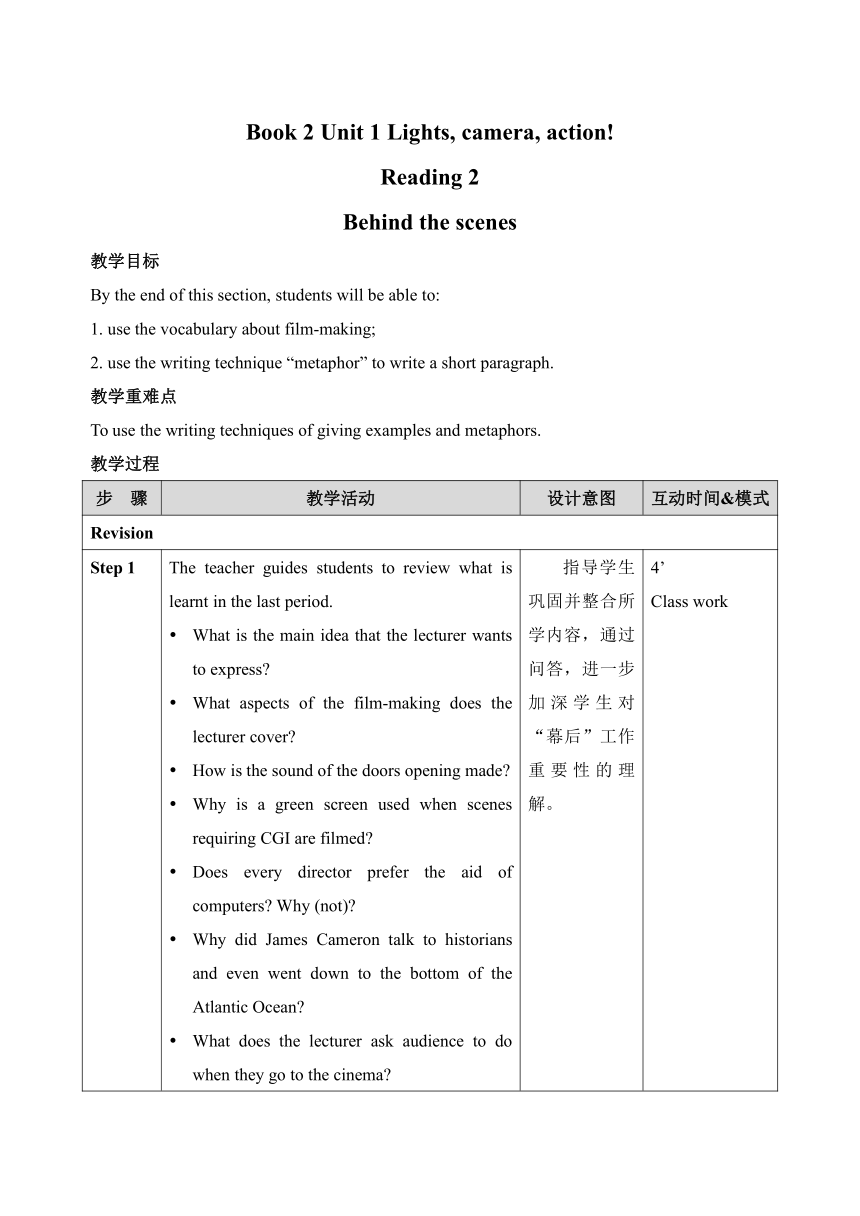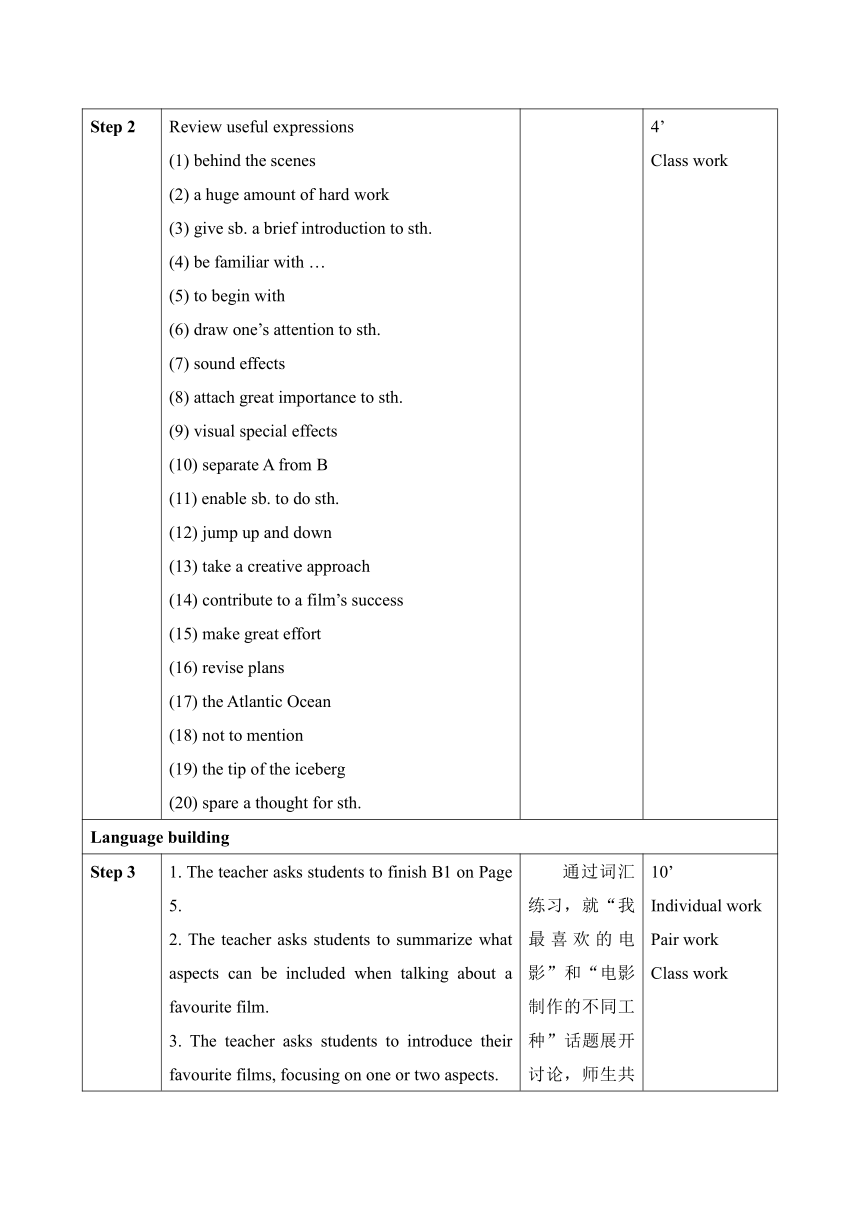牛津译林版(2019)必修 第二册 Unit1 Lights,camera,action! Reading2教案(表格式)
文档属性
| 名称 | 牛津译林版(2019)必修 第二册 Unit1 Lights,camera,action! Reading2教案(表格式) |  | |
| 格式 | docx | ||
| 文件大小 | 34.3KB | ||
| 资源类型 | 教案 | ||
| 版本资源 | 牛津译林版(2019) | ||
| 科目 | 英语 | ||
| 更新时间 | 2022-04-10 08:31:49 | ||
图片预览


文档简介
Book 2 Unit 1 Lights, camera, action!
Reading 2
Behind the scenes
教学目标
By the end of this section, students will be able to:
1. use the vocabulary about film-making;
2. use the writing technique “metaphor” to write a short paragraph.
教学重难点
To use the writing techniques of giving examples and metaphors.
教学过程
步 骤 教学活动 设计意图 互动时间&模式
Revision
Step 1 The teacher guides students to review what is learnt in the last period. What is the main idea that the lecturer wants to express What aspects of the film-making does the lecturer cover How is the sound of the doors opening made Why is a green screen used when scenes requiring CGI are filmed Does every director prefer the aid of computers Why (not) Why did James Cameron talk to historians and even went down to the bottom of the Atlantic Ocean What does the lecturer ask audience to do when they go to the cinema 指导学生巩固并整合所学内容,通过问答,进一步加深学生对“幕后”工作重要性的理解。 4’ Class work
Step 2 Review useful expressions (1) behind the scenes (2) a huge amount of hard work (3) give sb. a brief introduction to sth. (4) be familiar with … (5) to begin with (6) draw one’s attention to sth. (7) sound effects (8) attach great importance to sth. (9) visual special effects (10) separate A from B (11) enable sb. to do sth. (12) jump up and down (13) take a creative approach (14) contribute to a film’s success (15) make great effort (16) revise plans (17) the Atlantic Ocean (18) not to mention (19) the tip of the iceberg (20) spare a thought for sth. 4’ Class work
Language building
Step 3 1. The teacher asks students to finish B1 on Page 5. 2. The teacher asks students to summarize what aspects can be included when talking about a favourite film. 3. The teacher asks students to introduce their favourite films, focusing on one or two aspects. 通过词汇练习,就“我最喜欢的电影”和“电影制作的不同工种”话题展开讨论,师生共同探讨电影的幕后制作,无数人默默无闻地付出,实现迁移创新。 10’ Individual work Pair work Class work
Step 4 1. The teacher asks students to work in pairs to finish Part B2 on Page 5, guiding them to have a comprehensive understanding of different jobs in the film-making process and to realize that it is all these jobs that contribute to a great production. 2. The teacher has students comment on a common phenomenon: Many moviegoers are likely to skip the cast and credit roll. Possible answer: Most moviegoers only pay attention to actors and directors. Many people working behind the scenes remain unknown, and their names only appear at the end of the film. Actually, they devote their efforts to the production, which should be respected. So next time, we should remain seated, finishing the final cast and credit roll to show our respect. And I am sure this practice will be rewarding, which will help us understand the whole production better. 10’ Individual work Pair work Class work
Appreciation
Step 5 The teacher asks students to read “Learn this” in B3 to know what metaphors are. Then the teacher asks students to find the metaphors in this lecture to describe the fact that a lot of work is done behind the scenes in film-making. Possible answer: Just as the poor passengers on the real Titanic saw the tip of the iceberg, what we see on the cinema screen is just the tip of the huge iceberg of film-making. 学习文中暗喻的使用,引导学生体会暗喻在文中的作用。 5’ Individual work
Application
Step 6 The teacher asks students to write a metaphor of their own to describe the film-making process. Possible answer: A good film-making team is a sophisticated machine. There are many different parts and they all need to work together smoothly for the film to be a success. Even the parts you cannot see are important in some way. 引导学生使用暗喻来描述电影制作的过程,运用所学。 10’ Individual work
Homework Finish the exercise on Page 62 in the workbook. 2’
Reading 2
Behind the scenes
教学目标
By the end of this section, students will be able to:
1. use the vocabulary about film-making;
2. use the writing technique “metaphor” to write a short paragraph.
教学重难点
To use the writing techniques of giving examples and metaphors.
教学过程
步 骤 教学活动 设计意图 互动时间&模式
Revision
Step 1 The teacher guides students to review what is learnt in the last period. What is the main idea that the lecturer wants to express What aspects of the film-making does the lecturer cover How is the sound of the doors opening made Why is a green screen used when scenes requiring CGI are filmed Does every director prefer the aid of computers Why (not) Why did James Cameron talk to historians and even went down to the bottom of the Atlantic Ocean What does the lecturer ask audience to do when they go to the cinema 指导学生巩固并整合所学内容,通过问答,进一步加深学生对“幕后”工作重要性的理解。 4’ Class work
Step 2 Review useful expressions (1) behind the scenes (2) a huge amount of hard work (3) give sb. a brief introduction to sth. (4) be familiar with … (5) to begin with (6) draw one’s attention to sth. (7) sound effects (8) attach great importance to sth. (9) visual special effects (10) separate A from B (11) enable sb. to do sth. (12) jump up and down (13) take a creative approach (14) contribute to a film’s success (15) make great effort (16) revise plans (17) the Atlantic Ocean (18) not to mention (19) the tip of the iceberg (20) spare a thought for sth. 4’ Class work
Language building
Step 3 1. The teacher asks students to finish B1 on Page 5. 2. The teacher asks students to summarize what aspects can be included when talking about a favourite film. 3. The teacher asks students to introduce their favourite films, focusing on one or two aspects. 通过词汇练习,就“我最喜欢的电影”和“电影制作的不同工种”话题展开讨论,师生共同探讨电影的幕后制作,无数人默默无闻地付出,实现迁移创新。 10’ Individual work Pair work Class work
Step 4 1. The teacher asks students to work in pairs to finish Part B2 on Page 5, guiding them to have a comprehensive understanding of different jobs in the film-making process and to realize that it is all these jobs that contribute to a great production. 2. The teacher has students comment on a common phenomenon: Many moviegoers are likely to skip the cast and credit roll. Possible answer: Most moviegoers only pay attention to actors and directors. Many people working behind the scenes remain unknown, and their names only appear at the end of the film. Actually, they devote their efforts to the production, which should be respected. So next time, we should remain seated, finishing the final cast and credit roll to show our respect. And I am sure this practice will be rewarding, which will help us understand the whole production better. 10’ Individual work Pair work Class work
Appreciation
Step 5 The teacher asks students to read “Learn this” in B3 to know what metaphors are. Then the teacher asks students to find the metaphors in this lecture to describe the fact that a lot of work is done behind the scenes in film-making. Possible answer: Just as the poor passengers on the real Titanic saw the tip of the iceberg, what we see on the cinema screen is just the tip of the huge iceberg of film-making. 学习文中暗喻的使用,引导学生体会暗喻在文中的作用。 5’ Individual work
Application
Step 6 The teacher asks students to write a metaphor of their own to describe the film-making process. Possible answer: A good film-making team is a sophisticated machine. There are many different parts and they all need to work together smoothly for the film to be a success. Even the parts you cannot see are important in some way. 引导学生使用暗喻来描述电影制作的过程,运用所学。 10’ Individual work
Homework Finish the exercise on Page 62 in the workbook. 2’
